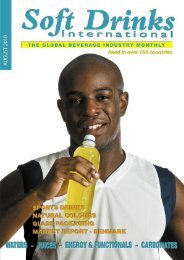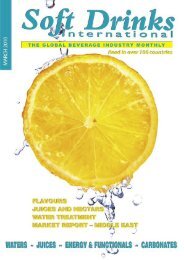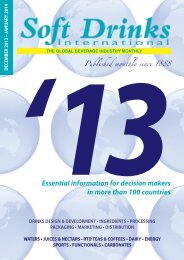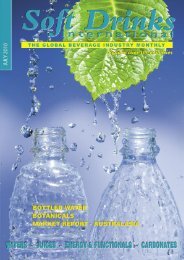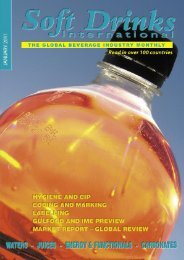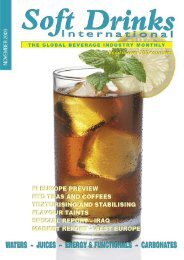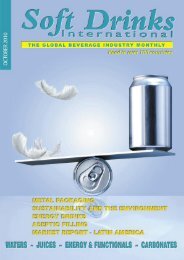SDI JUL09.qxd - Soft Drinks International
SDI JUL09.qxd - Soft Drinks International
SDI JUL09.qxd - Soft Drinks International
Create successful ePaper yourself
Turn your PDF publications into a flip-book with our unique Google optimized e-Paper software.
28 BEVERAGE FOCUS<br />
<strong>Soft</strong> <strong>Drinks</strong> <strong>International</strong> – JULY 2009<br />
The oldest soft<br />
drink<br />
still has global potential<br />
Packaged water<br />
will continue to<br />
play its part in<br />
the growth of<br />
soft drinks,<br />
reports Richard<br />
Corbett.<br />
The roots of the soft drinks industry can be<br />
traced to some of the water brands that are<br />
still very much alive and well today. Swedish<br />
favourite Ramlösa dates back to the year 1707<br />
and still carries the picture of its founder Johan<br />
Jacob Döbelius. Popular Italian brand San<br />
Pellegrino has been produced for over 600 years<br />
and it is even reputed to have been sampled by<br />
Leonardo da Vinci. Today these products are<br />
available all over the world and according to<br />
Global research specialist, Canadean, each consumer<br />
now drinks nearly 23 litres of packaged<br />
water annually. Packaged waters have played a<br />
critical part in the birth and development of the<br />
global soft drinks industry.<br />
All those years ago the development of the<br />
sparkling water segment stemmed from their asso-<br />
Source: Canadean<br />
Canadean anticipate still water to remain an important driver in soft drinks but not as much<br />
as it once was.<br />
West Europe will have a shrinking influence in the global packaged water market.<br />
Source: Canadean<br />
ciation with good health – even today in parts of<br />
East Europe sparkling water consumption is still<br />
often seen as medicinal. Back in 1707, according<br />
to Döbelius, Ramlösa could be used to cure<br />
scurvy, vertigo and gout, as well as trembling<br />
limbs. The water even helped those unfortunate<br />
enough to suffer from bad-smelling breath. In<br />
modern times though, still waters have been the<br />
engine behind the rapid enlargement of the category<br />
and consequently they have taken an ever<br />
rising portion of the market; today this stands at<br />
more than three quarters of the category. Still<br />
waters are a good fit with the modern health conscious<br />
consumer in the developed world, while in<br />
the developing parts still waters offer the security<br />
that they are safe to drink.<br />
The original soft drink<br />
The success of packaged waters has contributed to<br />
the expansion of the soft drinks market as a whole<br />
and they now account for 29% of all soft drinks<br />
traded globally – at the turn of the century that<br />
was 22%. The market for packaged waters has<br />
jumped by as much as 80% since 2000 to reach<br />
around 150 billion litres. At the same time the carbonates<br />
category has expanded by nearer 20% but<br />
remains the giant of the sector with 4 in every 10<br />
litres consumed around the world being a carbonated<br />
soft drink.<br />
PET - the enabler<br />
Of course without the right packaging, the soft<br />
drinks sector would not have got off the ground,<br />
and in the case of packaged water, PET has played<br />
a significant role in its development. PET has<br />
enabled water to be consumed on the move and<br />
this channel has been a key driver in helping sales<br />
reach new thirst quenching opportunities. In the<br />
Horeca channel and among premium products,<br />
glass remains very popular; consumers associate<br />
glass with quality but PET has significant handling<br />
advantages to ease mobility and make it<br />
more appropriate to a plethora of consumption<br />
occasions. The continuous rise of predominantly<br />
still waters has thus coincided with the dramatic<br />
escalation in PET use. PET now makes up well<br />
over 80% of all water packaging, a figure that is<br />
still rising. PET seems unstoppable and it is realistic<br />
to expect its share to continue to rise above<br />
90% in the longer term.




